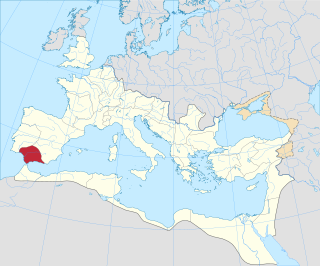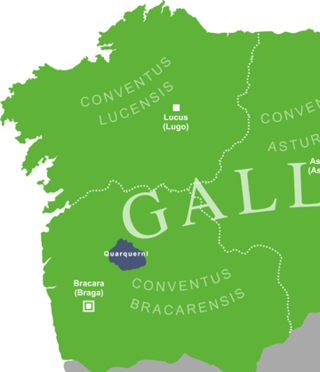
Lusitania was an ancient Iberian Roman province encompassing most of modern-day Portugal and a large portion of western Spain. Romans named the region after the Lusitanians, an Indo-European tribe inhabiting the lands.

Hispania Tarraconensis was one of three Roman provinces in Hispania. It encompassed much of the northern, eastern and central territories of modern Spain along with modern northern Portugal. Southern Spain, the region now called Andalusia, was the province of Hispania Baetica. On the Atlantic west lay the province of Lusitania, partially coincident with modern-day Portugal.
Decimus Junius Brutus Callaicus was a consul of the Roman Republic for the year 138 BC together with Publius Cornelius Scipio Nasica Serapio. He was an optimate politician and a military commander in Hispania and in Illyria. He was the son of Marcus Junius Brutus and brother of Marcus Junius Brutus. He had a son also named Decimus Junius Brutus and his grandson was Decimus Junius Brutus Albinus.

Hispania Baetica, often abbreviated Baetica, was one of three Roman provinces created in Hispania on 27 BC. Baetica was bordered to the west by Lusitania, and to the northeast by Tarraconensis. Baetica remained one of the basic divisions of Hispania under the Visigoths. Its territory approximately corresponds to modern Andalusia.

Gallaecia, also known as Hispania Gallaecia, was the name of a Roman province in the north-west of Hispania, approximately present-day Galicia, northern Portugal, Asturias and Leon and the later Kingdom of Gallaecia. The Roman cities included the port Cale (Porto), the governing centers Bracara Augusta (Braga), Lucus Augusti (Lugo) and Asturica Augusta (Astorga) and their administrative areas Conventus bracarensis, Conventus lucensis and Conventus asturicensis.

Tarraco is the ancient name of the current city of Tarragona. It was the oldest Roman settlement on the Iberian Peninsula. It became the capital of Hispania Tarraconensis following the latter's creation during the Roman Empire.

The Bracari or Callaeci Bracari were an ancient Celtic tribe of Gallaecia, living in the northwest of modern Portugal, in the province of Minho, between the rivers Tâmega and Cávado. After the conquest of the region beginning in 136BC, the Romans established the Augustan citadel of Bracara, modern Braga, in 20 BC.

The Quaquerni or Querquerni were an ancient tribe of Gallaecia, living in the Baixa Limia region of southern Galicia, where the Roman fort of Aquis Querquennis has been found.

The Turduli Oppidani or Turdulorum Oppida, were a pre-Roman coastal people in present-day Portugal, related to the Turduli Veteres and akin to the Callaeci-Lusitanians.

Aquae Flaviae is the ancient Roman city and former bishopric of Chaves, a municipality in the Portuguese district of Vila Real.

The Bletonesii were one of the pre-Roman Celtic peoples of the Iberian Peninsula, dwelling around the city of Bletisa or Bletisama, located in modern Ledesma in the province of Salamanca, Spain. If the placement in Bletisa is correct, they lived near the Vettones. A hospitality token dated to AD 27 mentions the "senate and people of Bletisama," and the name Bletonesii as found in Plutarch may be equivalent to the Bletisamenses found in inscriptions.

The Arevaci or Aravaci, were a Celtic people who settled in the central Meseta of northern Hispania and dominated most of Celtiberia from the 4th to late 2nd centuries BC. The Vaccaei were their allies.

Hispania was the Roman name for the Iberian Peninsula. Under the Roman Republic, Hispania was divided into two provinces: Hispania Citerior and Hispania Ulterior. During the Principate, Hispania Ulterior was divided into two new provinces, Baetica and Lusitania, while Hispania Citerior was renamed Hispania Tarraconensis. Subsequently, the western part of Tarraconensis was split off, initially as Hispania Nova, which was later renamed "Callaecia". From Diocletian's Tetrarchy onwards, the south of the remainder of Tarraconensis was again split off as Carthaginensis, and all of the mainland Hispanic provinces, along with the Balearic Islands and the North African province of Mauretania Tingitana, were later grouped into a civil diocese headed by a vicarius. The name Hispania was also used in the period of Visigothic rule. The modern place names of Spain and Hispaniola are both derived from Hispania.

The Pellendones were an ancient pre-Roman Celtic people living on the Iberian Peninsula. From the early 4th century BC they inhabited the region near the source of the river Duero in what today is north-central Spain. The area comprises the north of Soria, the southeast of Burgos and the southwest of La Rioja provinces.

The Romanization of Hispania is the process by which Roman or Latin culture was introduced into the Iberian Peninsula during the period of Roman rule.
The territory of modern-day Portugal was Romanized following the events of the Second Punic War, through the Roman conquest of the Iberian Peninsula.

Segóbriga was an important Celtic and Roman city, and is today an impressive site located on a hill near the present town of Saelices. Research has revealed remains of important buildings, which have since been preserved and made visible in the Archaeological Park. It was declared a National Monument on June 3, 1931, and is now considered cultural heritage under the official denomination Bien de Interés Cultural which comes with extensive legal protections.













